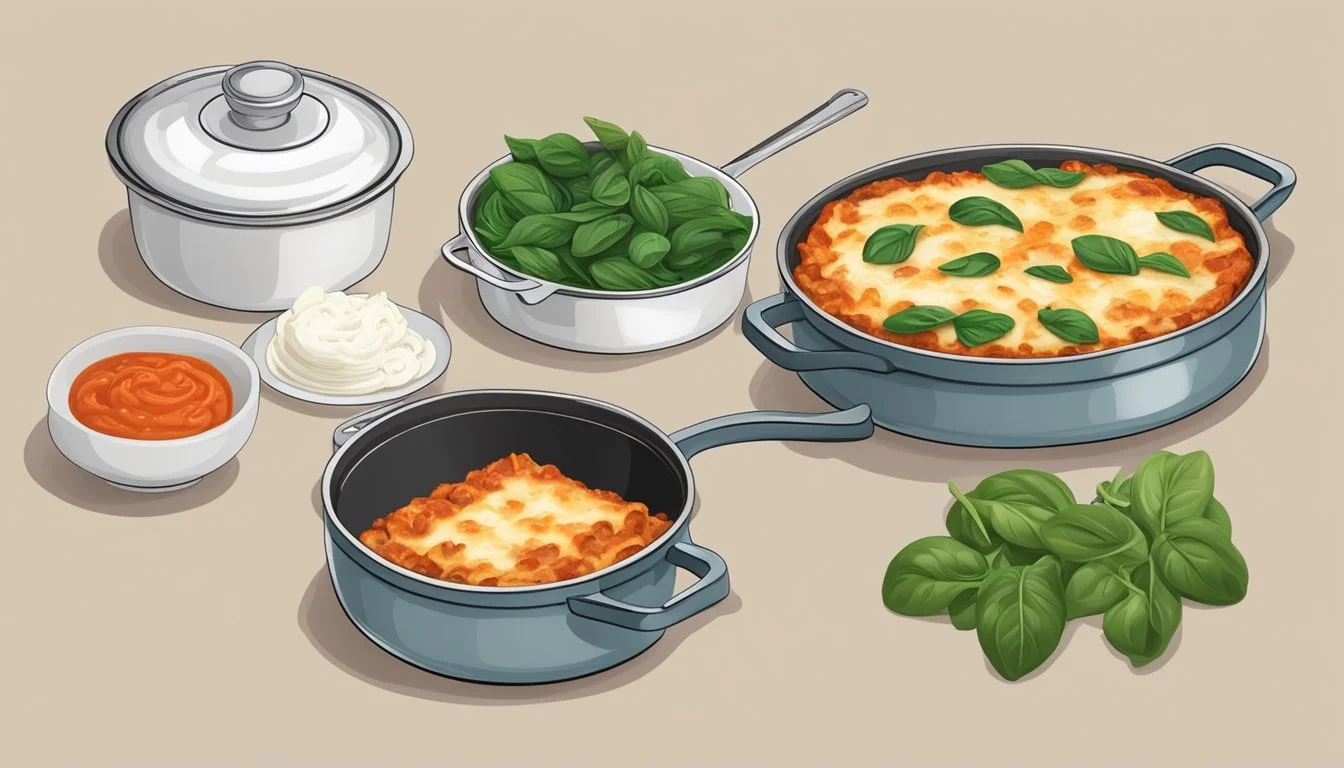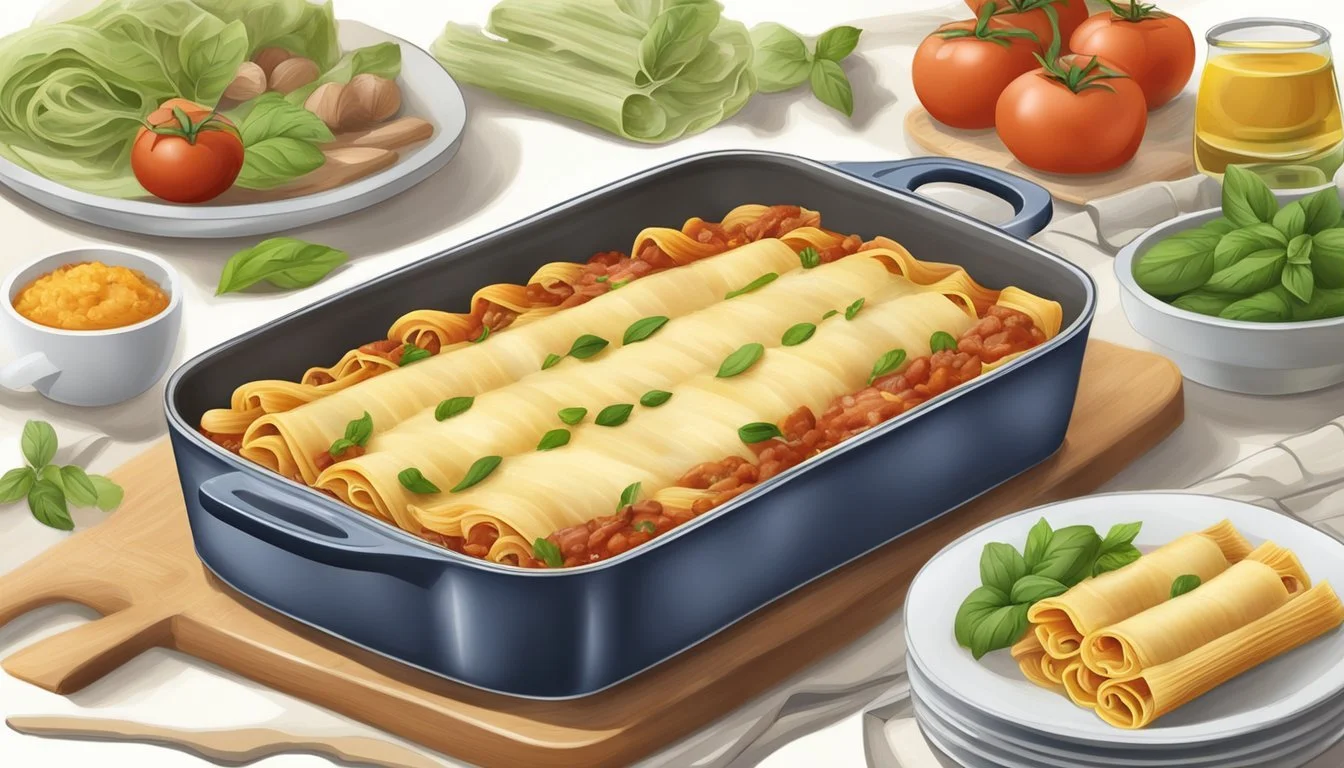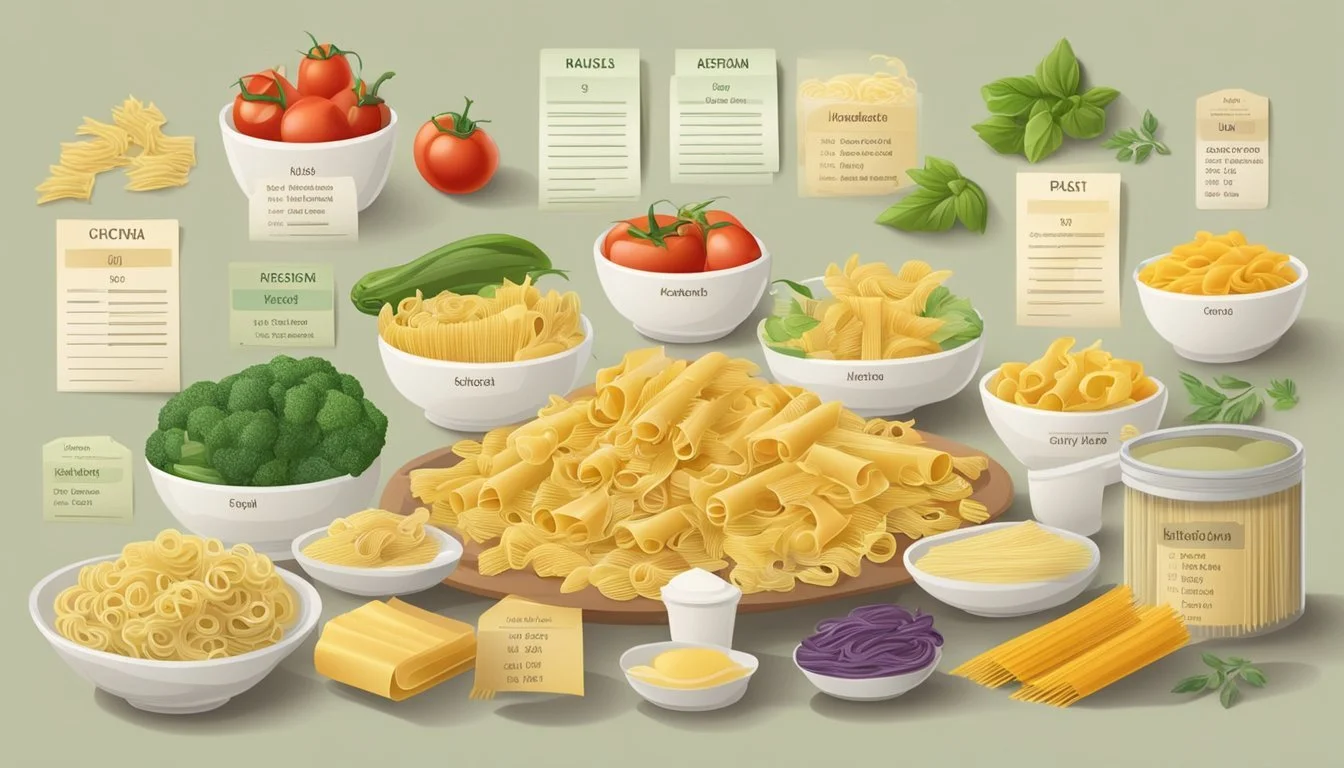Manicotti Pasta Substitutes
Top Alternatives for Your Italian Dishes
Manicotti, a classic Italian comfort food, is known for its large tubular shape and rich filling, usually comprising a blend of cheeses, meats, and sometimes vegetables. The heartiness of baked manicotti, often enveloped in a savory tomato sauce and smothered in melted cheese, makes it a beloved dish for family gatherings or a cozy dinner at home. Yet, cooking traditional manicotti might not always be feasible, whether it's due to dietary preferences, lack of ingredients, or a desire to explore culinary variations.
The popularity of exploring alternatives in cooking has led to the discovery of various pasta (What wine goes well with pasta?) substitutes that can serve as a stand-in for manicotti shells. These substitutes not only provide an inventive twist on the original recipe but also cater to diverse dietary needs. For instance, crepe batter, with a soft and thin texture, can mimic the delicate encasement that manicotti pasta provides. Crepes can be easily made from pantry staples like flour, eggs, and milk, and offer a similar surface for encasing rich, savory fillings.
For cooks looking to save time or simply try something different, replacing manicotti shells with readily available options can reinvent the dish while still preserving its essence. Some alternatives offer added convenience without compromising on the expected flavors and textures that make Italian dishes so satisfying. Each substitute discussed brings its unique properties, transforming the traditional manicotti into a new experience while maintaining the fundamental elements that make it a comfort food classic.
Understanding Manicotti
The reader is about to explore the traditional Italian dish known as manicotti, delving into its heritage and the quintessential elements that make up its classic recipe.
Definition and Origins
Manicotti, an Italian term meaning "little sleeves," refers to large tube-shaped pasta that is intended for stuffing and baking. It is a cherished dish in Italian-American cuisine, although it takes inspiration from Italian dishes such as cannelloni. Often associated with celebratory events and family gatherings, manicotti embodies the heart of Italian culinary traditions, which prioritize generous fillings and robust flavors.
Classic Ingredients
The core components of manicotti involve a harmonious blend of cheeses and seasonings.
Cheeses:
Ricotta Cheese: The primary cheese used for stuffing, providing a creamy and mildly sweet flavor.
Mozzarella Cheese: Often added for its melting qualities, contributing to the dish's gooey texture.
Parmesan Cheese: Used for its sharp taste, adding depth of flavor to the manicotti.
Additional Filling Ingredients:
Eggs: Serve as a binder for the cheese mixture.
Salt and Pepper: Essential seasonings to enhance the natural flavors of the cheese and pasta.
Spinach: A popular vegetable addition, providing a contrast in texture and an earthy note.
Each ingredient plays a crucial role in achieving the rich and comforting taste that manicotti is known for. The dish is typically completed by enveloping the stuffed pasta in a savory tomato sauce before baking, allowing all flavors to meld beautifully within the oven's heat.
Preparing Manicotti Pasta
In preparing manicotti, one must pay attention to the texture of the pasta, the richness of the filling, and the perfect balance of flavors achieved through baking.
Cooking Manicotti Shells
To ensure that the manicotti shells maintain optimum texture, they need to be boiled until al dente. Typically, this involves placing the shells in a pot of boiling water with a pinch of salt and cooking for approximately 7-8 minutes. The goal is to cook them just enough so they retain some firmness, which allows for easier handling and stuffing. After boiling, they should be rinsed with cold water to halt the cooking process.
Creating the Filling
A classic ricotta filling forms the heart of a baked manicotti dish. The filling usually comprises equal parts of ricotta, mozzarella, and parmesan cheeses, combined with beaten eggs to help bind the mixture. Seasoning is important; salt and pepper should be added to taste, and herbs such as parsley may be included. For extra taste and nutrition, chopped spinach can be mixed into the cheese filling.
Ingredients Quantity Ricotta cheese 1 cup Mozzarella cheese 1 cup Parmesan cheese 1/2 cup Eggs 2 Salt 1 tsp Pepper 1/2 tsp Spinach (optional) 1/2 cup
Filling and Baking Techniques
Once the manicotti shells are cooked and the filling is ready, the assembly can begin. Preheat the oven to 375°F. An effective method for stuffing the shells is to use a piping bag or a plastic bag with the corner snipped off. Gently fill each shell with the ricotta mixture and lay them in a greased baking dish. Once all the shells are filled and in place, cover them with a tomato-based sauce to keep them moist while baking. Cover the dish with aluminum foil and bake for approximately 25-30 minutes. Remove foil and bake for an additional 10-15 minutes until the top is golden and the cheese is bubbly.
Substitute Options for Manicotti Pasta
Crafting a satisfying Manicotti dish doesn't always require traditional pasta shells. The following substitutes offer a range of textures and dietary accommodations, from thin crepes to various pasta alternatives that maintain the dish’s essence.
Using Crepes or Crespelle
A delightful twist on Manicotti can be achieved through crepes or crespelle. These thin, smooth pancake-like substitutes can be made by pouring crepe batter into a hot crepe pan, yielding flexible wrappers ideal for stuffing with cheese and spinach or meat fillings. The crepes should be filled and rolled similar to standard Manicotti, delivering the same satisfying experience.
Alternative Pasta Types
Alternative pasta types can serve as a substitute for the classic Manicotti. Similar pasta tubes include cannelloni and large pasta shells, which can be filled with an array of ingredients. Additionally, lasagna sheets can be manipulated as a stand-in. Simply boil the sheets until pliable, cut into rectangles, add filling, roll them up, and bake as you would traditional Manicotti.
Gluten-Free and Low-Carb Substitutes
For those adhering to gluten-free or low-carb diets, substituting Manicotti pasta is still plausible. Zucchini slices, when cut into thin, flat strips, can be used as a gluten-free option. After a quick grill or sear to remove moisture, they become pliable for rolling with fillings. Another option is to use slices of eggplant or pre-cooked lasagna noodles that are gluten-free. These substitutes offer a similar structure to pasta tubes while aligning with dietary restrictions.
Accompanying Sauces and Additions
Selecting the right sauce and additions can transform manicotti from a simple stuffed pasta into a rich and satisfying dish. The ideal pairing of sauces and fillings not only complements the chosen pasta substitute but also balances flavors and textures.
Tomato-Based Sauces
Tomato-based sauces bring a classic, tangy profile to manicotti. They commonly include ingredients like crushed fire-roasted tomatoes, minced garlic, chopped onion, and a blend of herbs such as basil or oregano. For instance, a sauce may start with olive oil in a pan, to which garlic and onions are added and sautéed until fragrant. Tomatoes and herbs are then introduced, simmering to a slightly thickened consistency that wraps well around filled pasta.
White and Specialty Sauces
Bechamel and cream sauces offer a creamy and indulgent alternative to tomato-based varieties. A basic bechamel sauce might begin with a roux of flour and butter, with milk gradually whisked in until the sauce is smooth. Cheese, such as Parmigiano Reggiano, can be stirred into the sauce, adding a rich depth. Specialty sauces may integrate pesto or even a roasted red pepper coulis for a twist on tradition.
Additional Fillings and Toppings
For fillings and toppings, there's a wide array of both vegetarian and meat options. One could add cooked, crumbled sausage to a cheese mixture of ricotta, mozzarella, and Parmesan, seasoned with parsley and other herbs for a meat filling. Or, for a vegetarian variant, roasted vegetables and seasoned tofu can serve as a nutritious and flavorful filling. Toppings often include additional grated cheese or a sprinkle of herbs to complete the dish.
Serving and Storing Manicotti
When it comes to serving manicotti, ensuring it is properly heated through is paramount for optimal taste and texture. For those looking to prepare manicotti ahead of time or store leftovers, proper freezing and reheating techniques can maintain its quality and save time during busy events like christmas dinners.
Proper Reheating Methods
Manicotti is best reheated in the oven to preserve its texture. For individual portions, one should preheat their oven to 350°F, cover the manicotti with aluminum foil to prevent it from drying out, and bake until it's heated through, approximately 15-20 minutes. For microwave reheating, it's advisable to use a microwave-safe dish, cover with a microwave-safe lid or wrap, and heat on a medium setting until warm, usually for 2-3 minutes, stirring halfway through if possible.
Make-Ahead and Freezing Tips
For make-ahead convenience, manicotti can be assembled and refrigerated up to 24 hours before baking. It's as simple as covering it with plastic wrap and storing it in the fridge. When ready to bake, one should add an additional 5-10 minutes to the baking time.
To freeze manicotti:
Assemble the dish without baking and wrap it tightly in plastic wrap.
Overwrap with aluminum foil to prevent freezer burn.
Label with the date and can be stored frozen for up to 2 months.
When ready to serve, manicotti can be baked from frozen; it will require about 1 hour at 350°F, covered with foil.
These storing and reheating methods ensure that manicotti can be enjoyed with the same freshness and flavor as when it was first prepared.
Nutritional Information
When considering substitutes for manicotti pasta, one must be mindful of the nutritional content, including caloric values and macronutrient profiles. It's important for individuals adhering to specific dietary considerations, such as gluten-free, vegetarian, or low-carb diets, to choose options that align with their health goals.
Calories and Macronutrients
Substitute Calories per serving Carbohydrates Proteins Fats Crepe Batter Varies by recipe High Moderate Low Ricotta Cheese Approx. 222 kcal Low High High Marinara Sauce Varies by brand Moderate Low Low
Crepe Batter: Typically used as an alternative for those seeking a thinner and delicate texture. They are usually high in carbs but can be adjusted for low-carb dietary needs by using alternative flours.
Ricotta Cheese: Usually present in manicotti fillings, high in protein and fats, contributing to the richness of the dish. For those monitoring fat intake, reduced-fat versions may be preferred.
Dietary Considerations
Gluten-Free: Options like crepe batters can be made using gluten-free flours, making them suitable for those with gluten intolerance or celiac disease.
Vegetarian: Manicotti dishes traditionally cater to vegetarian diets, given the common cheese and vegetable fillings, except for versions with meat sauces.
Low-Carb: Low-carb crepe batters can be made using alternative flours like almond or coconut flour, accommodating those on ketogenic diets.
Each substitute carries its own nutritional profile and should be considered in the context of one's overall dietary needs and restrictions.
Conclusion
Exploring substitutes for manicotti shells allows for creativity and flexibility in the kitchen. Crepes offer a delicate, tender wrap that pairs exceptionally with traditional manicotti fillings. Their simple ingredients, typically flour, eggs, milk, and a pinch of salt, are whisked to form a batter that cooks into thin, pliable sheets ideal for stuffing.
For those adhering to dietary restrictions or seeking healthier alternatives, various pasta substitutes exist. Rice noodles or brown rice pasta maintain an Italian dish's integrity while providing a gluten-free option. Kelp noodles and shirataki noodles introduce a unique texture and are both low-calorie and low-carb substitutes.
When preparing a manicotti recipe, the choice of substitute can impact both flavor and authenticity. For instance, cannelloni is a classic Italian pasta similar to manicotti but differs slightly in texture. While both can be filled with a range of ingredients, cannelloni uses smooth pasta, whereas traditional manicotti typically employs ridged tubes.
The table below summarizes the key points of each substitute:
Substitute Considerations Authenticity Crepes Thin, delicate, easy to make Less authentic, but versatile Rice Noodles Gluten-free, lighter texture Diverges from Italian tradition Kelp Noodles Low-calorie, unique texture Far from traditional, health-focused Cannelloni Smooth pasta, close in size Most authentic alternative
Utilizing alternatives to manicotti shells is an innovative way to adapt recipes to personal tastes and nutritional preferences while still enjoying the essence of Italian cuisine.






